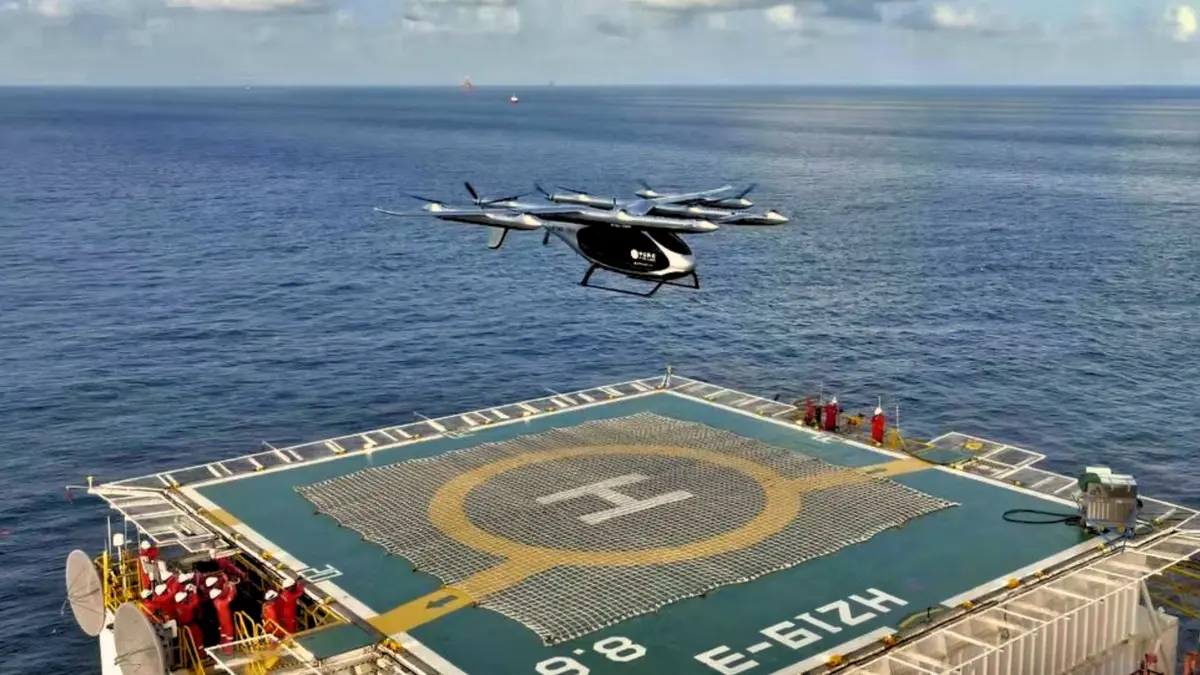For decades, offshore oil rigs have relied on sluggish ships or costly helicopters to move cargo. Now, China just rewrote that playbook with a flying machine that looks like it leapt out of a sci-fi novel—and it’s not fiction anymore.
Last week, the world’s first two-ton, all-electric cargo aircraft made its debut on a high-stakes supply run, hauling fruit and emergency medical supplies 150 kilometers across open sea to a floating oil platform in under an hour. The mission didn’t just deliver cargo—it delivered a glimpse into the future of logistics.
Meet the V2000CG “CarryAll”, China’s heavy-lift electric VTOL drone built by Autoflight. No cockpit. No pilot. No runway. Just vertical lift, rapid cruise, and a zero-emissions flight path from Shenzhen’s coast to the decks of China National Offshore Oil Corporation’s (CNOOC) rig. A trip that used to take 10 hours by boat now takes less than 60 minutes—with no crew, no fuel, and no weather delays.
This isn’t a prototype. It’s the first fully certified heavy eVTOL in China, already sold, delivered, and ready for routine deployment. And it’s not alone—around the world, from Germany’s Wingcopter to California’s MightyFly, a silent arms race is unfolding to dominate the next frontier of freight: mid-range, high-speed aerial delivery without the human overhead.
The Death of the Middle Mile
Supply chains have always had a problem with the “middle mile”—too short for aircraft, too long for trucks, too expensive for helicopters, and too slow for ships. The CarryAll obliterates that gap. With a 400 kg payload, 124 mph cruise speed, and a range of 124 miles on a single charge, this drone isn’t just a solution—it’s a category killer.
Imagine daily sorties carrying medical kits to offshore platforms, engine parts to stranded vessels, or urgent supplies across rugged terrain—all without touching a highway, a helipad, or a fueling station.
This is not a tweak. It’s a transformation.
A New Aerial Economy Is Being Born
Shenzhen has already built 300 drone logistics routes. Vertiports are going up next to hospitals and industrial parks. Regulations are catching up fast, and the appetite for near-instant delivery—especially in sectors where time equals money or lives—is insatiable.
The offshore oil industry, with its isolated platforms and constant resupply needs, is just the beginning. Disaster zones. Remote islands. Arctic bases. Mountain towns. Anywhere traditional logistics stumble, the drone swarm is coming.
The Sky’s Not the Limit Anymore
In a world where delivery time is currency and autonomy is king, the CarryAll isn’t just another drone—it’s a shot across the bow of every outdated supply chain on the planet. It replaces not just helicopters and boats, but layers of logistics bureaucracy and cost.
The future doesn’t arrive with a boom. It lands softly on a helipad, drops off your shipment, and takes off again—silently, electrically, and without waiting for anyone’s permission.
A 10-hour trip reduced to 58 minutes. That’s not an upgrade. That’s a revolution in motion.


